Study Highlights Variations in Access to Care for Opioid Use Disorder in Philadelphia
Using ‘secret shopper’ approach, University of Pennsylvania research identifies ways to reduce barriers for people seeking treatment

How quickly can someone get an appointment with a provider to treat opioid use disorder (OUD)? Does the provider accept that person’s insurance? Can the person seeking treatment get access to prescription medication during the first visit? Is counseling required to receive medication? And how long might someone have to wait on hold?
These are practical questions familiar to anyone who has ever made a medical appointment. But for someone who may have recently experienced a nonfatal overdose—a group that faces an estimated mortality rate of 5.5% within a year—the answers could mean the difference between life and death.
Recent research by the University of Pennsylvania funded by The Pew Charitable Trusts sought to answer these questions and others that can determine accessibility of treatment for people with OUD seeking care in Philadelphia. The research team used what is known as a “secret shopper” approach, reaching out directly to local providers to simulate the real-world experience of someone seeking care for themselves or a client.
The findings demonstrate that ease of access to evidence-based treatment varies significantly by providers throughout the city and identify several areas for improvement to reduce barriers to care.
Although the city has followed national trends of declining overall rates of overdose death in recent years, the opioid crisis remains a significant concern; Philadelphia has persistently had one of the highest overdose death rates among large U.S. cities and counties. According to a 2025 Pew survey, 44% of Philadelphians say they know someone with OUD and 34% say they know someone personally who has died from opioid use.
The city has a robust network of services in place to support individuals in or seeking treatment for OUD, but demand is ever evolving and outpaces supply. The treatment system, meanwhile, is known to be fragmented, complex, and often inaccessible.
Beginning in 2022, Pew worked with researchers at Penn to support this “secret shopper” study, which measured the use of best practices that support low-barrier access to treatment at doctor’s offices and treatment centers. A researcher posing as a case manager called local treatment providers to ask about getting a client who was recovering from a recent overdose into treatment and, specifically, access to buprenorphine, a medication that has proved effective in treating OUD.
Study Offers Insights Into Range of Practices to Treat Opioid Use Disorder in Philadelphia
How provider responses to questions compared with evidence-based practices, September 2022-January 2023
| "Case Worker" question | Evidence-based practice | Provider responses |
|---|---|---|
| Time to appointment | As soon as possible |
Median: 3 business days Range: 0-120 days |
| Time to prescription | First appointment |
45% Unsure 43% Yes 12% No |
| Counseling required in order to receive medication | Available but not required |
38% Unsure 36% Did not require counseling 26% Required counseling |
| Require abstinence to continue treatment | No | 54% Unsure 28% Continue buprenorphine 15% Discontinue buprenorphine or require higher level of care |
Source: Leonard Davis Institute of Health Economics, University of Pennsylvania
The study revealed opportunities for policy and practice changes that could help more people find, access, and stay in care that works for them and their path toward recovery.
Among the key findings were:
- Median wait time for a new patient to make an appointment was three business days, but with a very wide range between same-day appointments for some providers and up to four months out for others.
- Fewer than half of providers could confirm the ability to give a prescription at the first visit.
- Respondents indicated a lack of clarity and transparency about requirements, with many programs unable to confirm whether counseling was required to receive medication or to remain under their care.
Penn’s recently published policy brief highlights some key areas of opportunity for clinicians, policymakers, and health care payors to consider as they evaluate the findings of this research:
- Clinicians and treatment facilities can make sure that low-barrier treatment access is available for new and existing patients, including updated training for reception staff.
- Public health agencies can support provider education to adopt current evidence-based practices.
- Health insurance companies, including Medicaid, should create reimbursement incentives that prioritize rapid and consistent access to medication for OUD.
Philadelphians seeking treatment for OUD too often face barriers to accessing services when and where they need them. The Penn research points to feasible policy and practice reforms that stakeholders can support to help more people begin and remain in recovery.
Katie Martin is a project director and Jennifer Clendening is a manager with The Pew Charitable Trusts' Philadelphia research and policy initiative.









